East SIG Report May 2021
24th July 2021
Neil Muller
Host Paul Woolard opened the May meeting again via Zoom. This month he was seated with a small audience at Eley Road Hall, our normal meeting place before the pandemic hit. This being the first hybrid meeting from Eley Hall, feedback from the audio system had to be solved before the meeting could commence. After a short delay George Skarbek presented his normal Q&A segment.
Q. Why do we have so much trouble doing these hybrid meetings?
A. Whenever you have more than the one microphone in the room, you can have feedback problems. I know all those involved are very competent people and eventually they’ll sort it out.
Q. I’m having trouble with my Windows 10 machine. Win10 waas.medic.agent.exe is causing performance problems. When it starts up, it seems to be grabbing all the resources and nothing else will run. On start-up I can’t even bring up Task Manager, even when nothing else is currently running.
A. Although I haven’t heard of that problem, I’ve heard of similar problem where some rogue program grabs all the system resources. Because the problem is with a Windows application, that will make it a lot harder to resolve. It could have been a recent Windows update that has gone rogue. I suggest you do an update tonight as Microsoft may be aware of and have fixed the problem.
If you can’t bring up Task Manager in the usual way from the task bar, there are two other ways you can try. I prefer pressing Ctrl + Shift + Escape (Esc) or alternatively Ctrl + Alt + Delete. You may then be able to get into Resource Manager.
[John Hall] I’ve just done a Google search and it appears was medic.agent.exe has something to do with Windows Updates. I suggest going into Window Updates and turn off all updates. To do this, say that you’re on a metered connection and you don’t want Windows updates to start. Turn your computer off and reboot and all updates should stop.
Q. Does anyone know of a program that will sync a Windows PC with an Android tablet? I don’t want to sync the whole tablet, just Word documents. I’d like to be able to sync when the program recognises, I’m on a certain wi-fi connection.
A. I don’t know of a program that will do that, but if you connect between the devices with a cable, you will then be able to copy from one to the other.
[John Hall] Google Drive or Microsoft OneDrive could be used to store your Word documents and access them from either device.
Q. I have a relative’s laptop that boots up with a display, System Interrupt 100% in use, a few seconds later the CPU shuts down and a display shows the hard drive at 100% use. At that time the machine is unusable. I’ve run anti-virus and I’m current running sfc (system file checker) to see if there’s any problem there. Has anyone got any suggestions as the relative is leaving for overseas soon?
A. Almost certainly it’s not a virus. Viruses try to be invisible while doing their nasty work before they are noticed and you try to kill them. If you can start Task Manager that will tell you what program is taking up all of the CPU or hard disk.
There are many programs that can cause system interrupts. Therefore, system interrupt isn’t much of a clue. I would go to the Event Viewer and have a look there. You will need to look either under Application or System. Have a look at the time when things went to 100% and that may give you a clue what the culprit is. I’d say you’ve got a 30% chance there of tracking it down. You’ll have to press Ctrl + Shift + Esc or Ctrl + Alt + Del to stop the process and get into Task manager. Once you find what program is causing the problem, stop it. You can then uninstall it or stop it from starting.
[Questioner] The file that is causing the hard drive to run at 100% seems to be a different program each time the computer starts.
[Audience member] To speed up hard disk performance (to overcome slow operation) enable write caching in Windows 10. This unfortunately increases the risk of data loss in case of power failure.
How to: Open Device Manager Disc Drives Double-click the particular Disk Properties Policies Enable write caching. If this doesn’t do anything significant, try Opening Administrator Command Prompt and CHKDSK the disk.
[Audience member] I have a hard disk that is showing 100% disk use, but no programs are running. I did a Windows Check Disk (Chkdsk.exe) and found numerous bad sectors which Windows was trying to correct, thus causing the 100% usage. I’m currently trying to get all my data off this drive before the hard drive fails completely.
[Update from Questioner] As a result of the above problem, and the fact that an external keyboard is mandatory because 8 keyboard keys are unusable, a new laptop was purchased so the problem has not been solved.
Q. I put my laptop into sleep mode when I’ve finished using it, so that I don’t have to wait while it boots the next time it’s used. At night I close the lid, to put Windows into sleep mode, so it’s ready for the next use. I use sleep mode with my desk top computer without any problems, but my laptop keeps humming and is burning hot to touch in the morning. This is a gaming laptop so could that be the cause?
A. Again you will need to go into Task Manager to find how long it goes to sleep for and how deep the sleep is. Under power settings check whether the display goes off, the hard drive stops etc.. Because the laptop is so hot in the morning, something must be running while it is asleep. I suggest before you put it to sleep, open Task Manager and go to the tab that shows CPU and disk usage. When you wake the laptop up from its sleep, as Task Manager is still running you will be able to find what has been running while it’s asleep. You will then see what has been chewing up vast amounts of resources and causing the heat.
[Audience member] There used to be an old setting in Windows that would continually wake up Windows from sleep.
[George] That was called Wake on LAN and is used to wake a computer on a network when other family members want to use files on that computer. You can switch that off if it’s on. However, that wouldn’t cause the computer to run so hot.
Last month Dave Botherway gave a presentation on Zoom’s “Remote Control” feature. This month he presents the Microsoft equivalent called “Quick Assist”. Quick Assist has been available since Windows 8, but is still relatively unknown, namely due to the popularity of other sharing programs such as Team Viewer. Quick Assist is now used by MelbPC’s iHelp team after TeamViewer required MelbPC to take out a commercial licence.
Quick Assist allows 2 Windows 10 computers with a Microsoft account, to connect to one another on the internet. A person at one of the computers can then control the other to solve and fix any problems without the need to be sitting in front of the faulty computer. Both computers need to be turned on and the person needing assistance has to give approval before control is given to the other person. The person at the faulty computer can take back control at any time if concerned at what is happening.
Dave suggested the easiest way to find Quick Assist is to use the Windows Search button on the taskbar. After the first 3 letters had been entered in the search bar, Quick Assist appeared at the top of the list of search items. From the list click on Quick Assist and the “Quick Assist” window shown in Figure 1 appears.
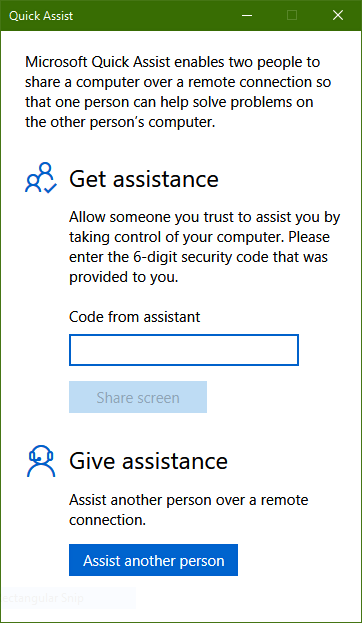
Figure 1 – Quick Assist Window
In the Quick Assist window two options are available, to “Get Assistance” from a remote person or to “Give Assistance” to another person.
Dave first demonstrated how to “Get Assistance” from a remote user, followed by the reverse process where he selected “Give Assistance” to another user. As both techniques are similar, only the more common option of giving assistance to a remote user will be shown in this report.
To give assistance both computers have to be on, running Windows 10 and have a Microsoft account. Quick Assist will not connect to a remote computer without someone sitting in front of that computer. This is necessary as the remote user needs to approve the connection before the helper can take control of the remote computer.
Select “Quick Assist” as outline earlier and select the “Assist another person” button. You’ll next be asked to enter your Microsoft account details. Once done “Quick Assist” generates a 6-digit security code that you need to give to the remote user you are helping.
The 6-digit code can be sent by mobile phone (voice or text) or by email to the remote user you are assisting. The security code generated only lasts 10 minutes before it expires and a new code is needed. The 10-minute limit does not apply once the connection is made.
In the window below the 6-digit security code, select the type of help that will be given. Here Dave selected “Provide instruction”. Once selected the Window refreshes and you select “I provide instructions”. A new window then opens where you have the option to “Take full control” or View screen”. Dave selected “Take full control” and then clicked the “Continue” button. Dave then waits for the remote user to grant permission. While waiting the helper sees a message “Waiting for the sharer to grant permission”. This process and those that follow, is outlined in the flow chart at the end of this report.
At the remote computer the user needs to opens “Quick Assist” and add their Microsoft account details before they can proceed. (Figure 1). When these details are confirmed, the 6-digit code under “Get assistance” is entered. Once the last digit is entered the “Share screen” button turns blue (becomes active) and is selected. The remote user will then see the message “Waiting for helper to set up this session”. After a short period, you see a new window titled “Share your screen”. This is where you give your permission for the helper to “Take full control” of your computer by selecting the “Allow” button.
After a short period, the remote computer is connected to the helper and displays a small toolbar at the top of the screen to indicate screen sharing is on. (Figure 2). The remote user can pause control of sharing by selecting the pause icon on this toolbar.

Figure 2 – Remote computer “Screen sharing on” toolbar
When the connection is complete, Dave can see the remote computer’s screen as if he was sitting in front of it. He is then able to control the remote computer with his mouse and keyboard. At the top of Dave’s screen is a toolbar showing icons that may be used to assist in diagnosing any problems. (Figure 3). After opening programs and adjusting the time on the remote computer, Dave selected “End” from the toolbar, to close Quick Assist and stop sharing.

Figure 3 – Quick Assist toolbar displayed on the helper’s computer
The following flow chart shows the various “Quick Assist” windows, in chronological order, that a helper and the remote user see when giving assistance to a remote user.
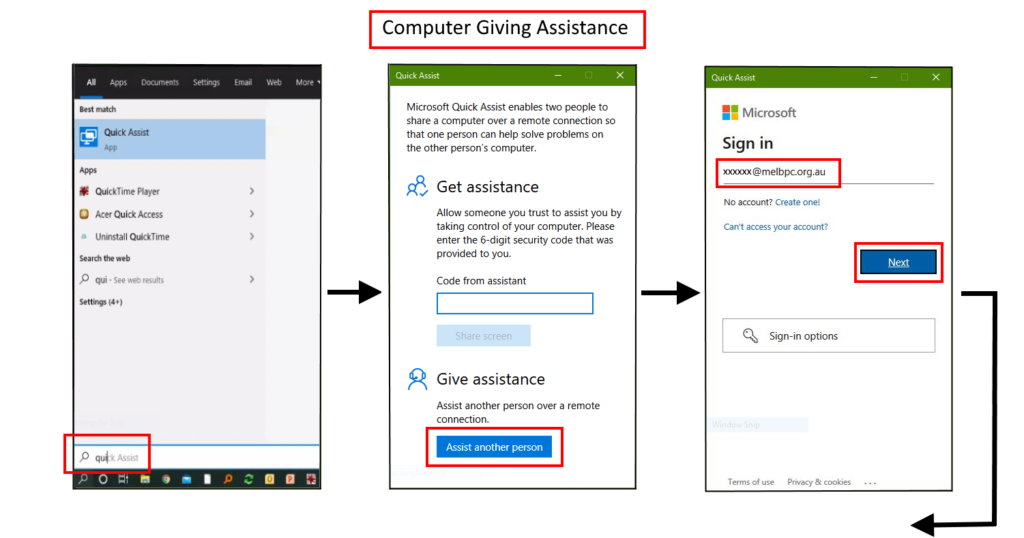

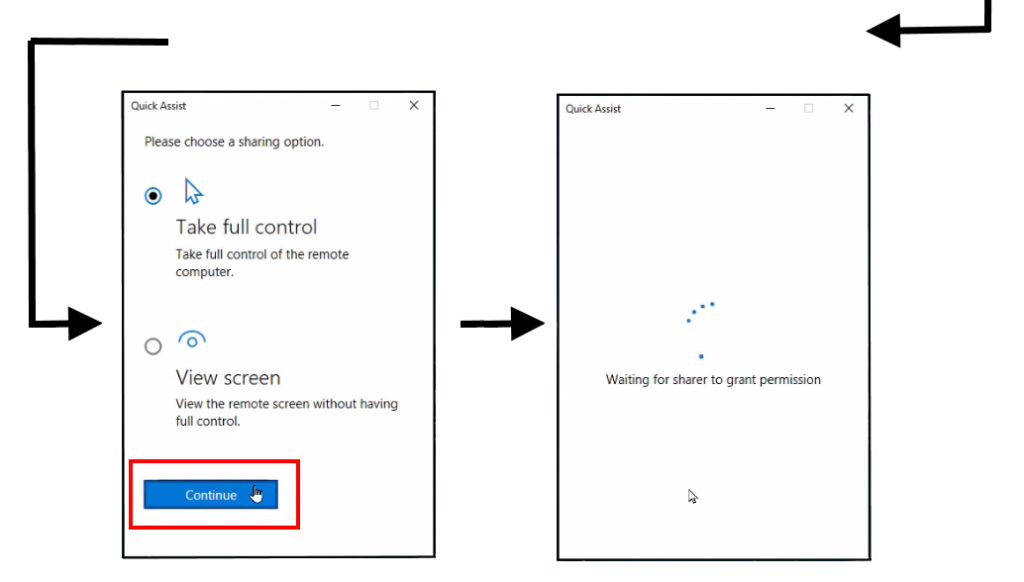
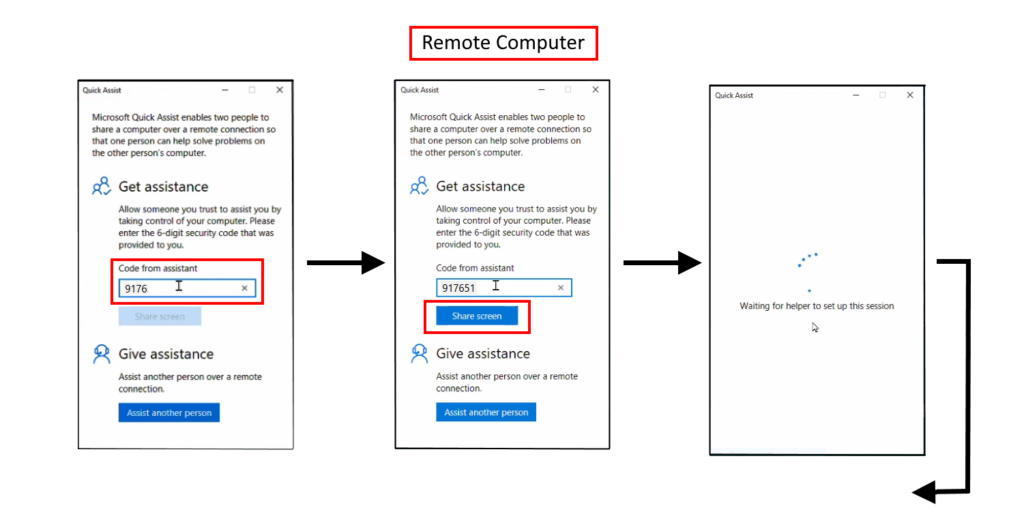
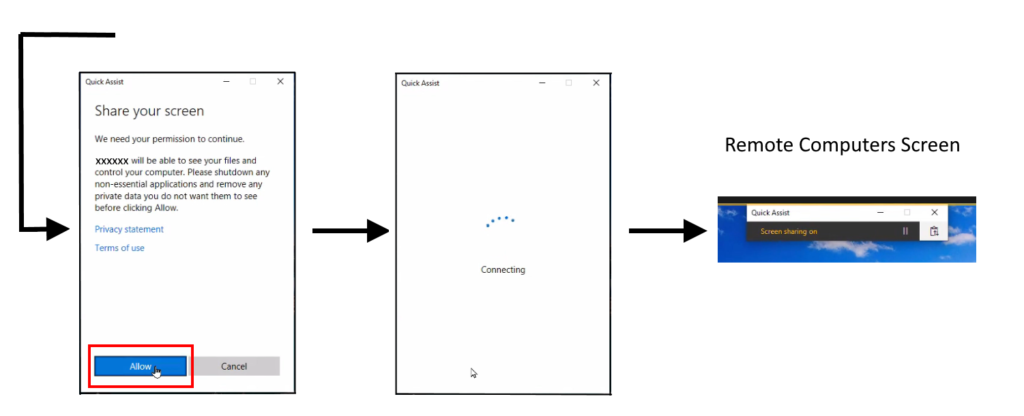
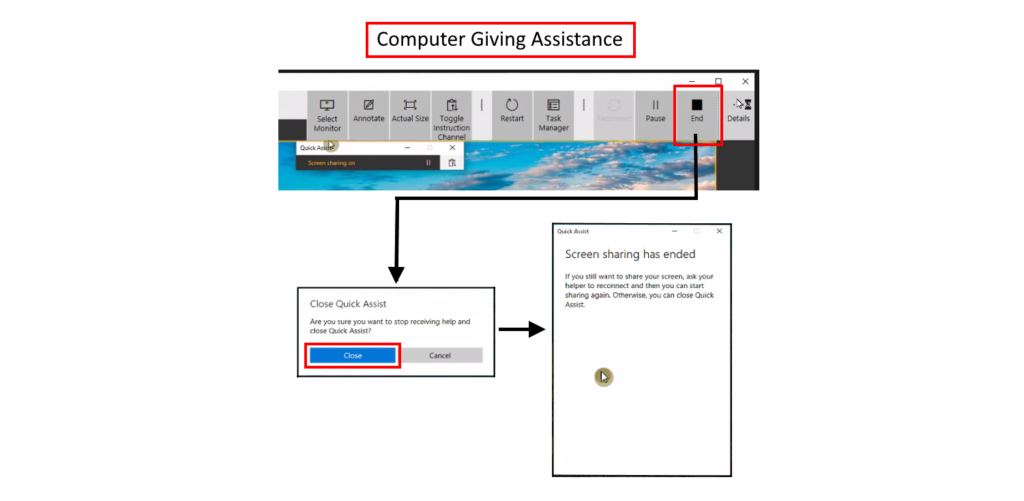
Questions followed and the meeting concluded with informal discussions between audience members related to using Quick Assist.



Recent Comments